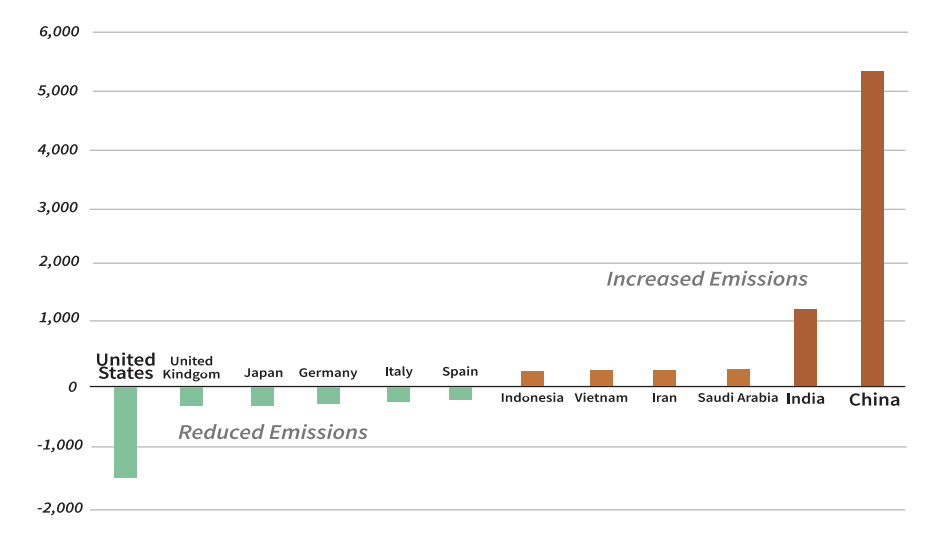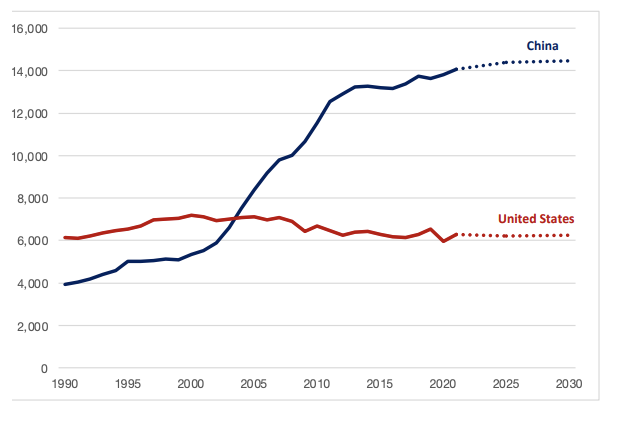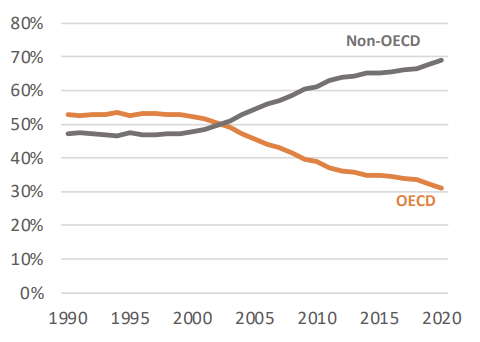This briefing paper is part of CRES Forum’s Understanding the Facts Series, providing substantive background information on why and how conservatives should lead on climate change policy. The issues and approaches are rooted in CRES Forum’s Conservative Climate Policy Directives. These directives were developed to help policymakers and the public better understand how policies can reduce greenhouse gas emissions while promoting U.S. prosperity and fostering economic growth for generations to come.
The CRES Conservative Climate Policy Directives are:
- Keep all options on the table to reduce emissions
- Lower costs, don’t force prices up, unintentionally or by design
- Support American innovation
- Promote nature-based solutions
- Eliminate regulatory barriers
- Link foreign aid and trade to global emissions goals
- Encourage transparency and accountability
- Leverage public-private partnerships
THE U.S. IS DECARBONIZING
Between 20051 and 2020, annual global carbon dioxide (CO2) emissions grew by 5.8 gigatons (Gt) – a roughly 20% increase. China accounted for about 92% of that growth. In this period, the United States led the world in cutting CO2 emissions by far, falling 24% by 2020 and achieving more absolute ton reductions than the next several emissions reducing countries combined. In contrast, China’s CO2 emissions between 2005 and 2020 grew by 84%. While U.S. emissions may go up or down on a year-over-year basis, the U.S. economy is on a decarbonization trend – and on that trend without punitive federal regulation or a national price on carbon.

Figure 1: U.S. CO2 Emissions (MMt)
Source: Olivier and Peters, and EDGAR
U.S. CO2 emissions fell by 11% in 2020, largely as a result of slow economic growth related to COVID-19. While increasing by roughly 6% in 2021, U.S. emissions are still below pre-pandemic levels and are about 20% lower than in 2005. During 2022, the U.S. Energy Information Administration (EIA) expects U.S. CO2 emissions to continue to rebound and grow by nearly 2%, with high natural gas prices complicating the Biden administration’s goal of reducing U.S. emissions by 50-52% by 2030, compared to 2005. EIA forecasts that emissions will grow by only 0.5% in 2023 resulting in emissions that are still about 3% lower than pre- pandemic 2019 levels.
THE DEVELOPING WORLD, LED BY CHINA, IS RESPONSIBLE FOR A GROWING SHARE OF EMISSIONS
A 2020 report published by the Climate Leadership Council (CLC) found that U.S. manufactured products are 40% more carbon efficient than the world average. This finding shows the substantial progress made by the United States over the past decade as natural gas and renewables displaced coal generation. World Bank data from nearly ten years ago indicated that the U.S. economy was only 29% cleaner than the average upper-income nation, 34% cleaner than the next largest energy producer (i.e., Russia), and 46% cleaner than China. Today, the average product made in China results in three times more carbon than if it were made in America.
U.S. manufactured products are 40% more carbon efficient than the world average.

Figure 2: Change in yearly CO2 Emissions 2005 – 2020 (MMt)
Source: Olivier and Peters; EDGAR
China surpassed the United States as the largest absolute emitter around 2005. Today, the level of Chinese emissions is more than twice that of the United States. Total GHG emissions in China for 2020 were estimated to be around 13.8 GTCO2e, up 1.3% from 2019. Given Beijing’s pledge under the Paris Agreement to peak its emissions around or before 2030, we expect Chinese total GHG emissions are likely to reach roughly 14.5 gigatons in 2030, an increase of about 73% from 2005 levels.

Figure 3: GHG yearly emissions comparing the U.S. and China (MMt)
Source: EDGAR; Projection data from Climate Action Tracker, https://climateactiontracker.org/
The U.S. share of global emissions will continue to decline sharply. When the United Nations Framework Convention on Climate Change (UNFCCC) was adopted in 1994, the United States accounted for 23% of the world’s CO2 emissions, compared to 13% for China. In 2020, U.S. CO2 emissions totaled 13% of the global total, while Chinese emissions climbed to 32%. As of 2019, China emitted more CO2 than all OECD countries combined.
Globally, non-OECD emissions are tracking a similar trend as China. Having outstripped OECD emissions in the early 2000s, non-OECD countries now represent 69% of global CO2 emissions, compared to 31% for OECD nations.


Figure 5: Global share of CO2 emissions, OECD vs. non-OECD
Source: EDGAR
CHINA’S ACTIONS AND POLICIES RUN COUNTER TO THE CONVENTIONAL WISDOMS AND ON CLIMATE
In terms of historical, cumulative emissions since 1750, the United States is the largest contributor, accounting for a quarter of the world’s total, followed by the EU-27 (17%) and China (14%). Since the UNFCCC’s formation, however, in 1994 (an indicator of when the world realized that global climate change was a problem that needed to be addressed), Chinese cumulative emissions have totaled 22% of the world’s total, compared to 18% for the United States and 11% for the EU. China’s cumulative contribution to CO2 emissions since the UNFCCC’s founding overtook the United States in 2013.
U.S. and broader OECD responsibility will decline further as Chinese and large emerging economy (e.g., India and South Africa) emissions grow significantly over the coming decades. Given current trends, China is likely to surpass the United States as the largest historical, cumulative emitter since 1750 around 2040 – or earlier if the United States accelerates its decarbonization.
This development is likely to realign international discussions on adaptation as Chinese and other non-OECD emissions become responsible for an increasing share of modern climate impacts, including those experienced in the United States. To avoid accountability, non-OECD economies are likely to maintain the argument that their per capita emissions are lower than those of the United States, but such a position ignores a basic scientific fact: only absolute emissions are relevant to climate change.
Currently, China’s domestic coal consumption accounts for 54% of the world’s total, compared to the U.S. share of 6%. Forecasts suggest a sharp decline in coal use in the United States and Europe as natural gas and renewables increase their penetration of the grid. Demand for coal between now and 2030, however, is expected to increase substantially in parts of Asia Pacific, particularly in Southeast Asia where electricity demand is expected to grow by 70%. As China continues to operate and build coal-fired power plants to meet those needs, it does so largely without any meaningful controls on carbon emissions.

Figure 6: New coal plants built since 2010
Source: “Coal Plants by Country,” Global Energy Monitor, https://globalenergymonitor.org/projects/global-coal-plant-tracker/
There are currently nearly 100 GW of new coal power plants under construction in China, with an additional 163 GW announced and permitted. According to press reports, the China Electricity Council, which represents the power sector, proposed greenlighting 290 GWs of new coal capacity — or more than the entire U.S. coal fleet. Chinese COVID-related economic plans have only reinforced this trend. While China has built many coal plants with efficient ultra-supercritical technology, these only represent 11% of the Chinese fleet, with 58% being less efficient, subcritical plants. Even if China was not building new coal plants, it shouldn’t be ignored that their existing coal fleet is responsible for 53 percent of the world’s coal-fired power generation.
China’s responsibility for future global climate change is probably much higher than what its trajectory for territorial emissions suggests. While China has committed to halt financing coal-fired projects abroad without many details, it is financing 33.5 GW of foreign coal projects that are in either the construction or planning stages. In 2019, prior to the financing announcement, one quarter of all coal plants (102 GW) under development outside of China had committed or proposed funding from Chinese financial institutions and companies.
Driven largely by China’s substantial growth in emissions, even if all countries fulfill their latest Paris Agreement pledges, with some submitted shortly before COP26 in November 2021, global emissions growth will likely result in missing the Paris 2° Celsius target by 0.4 to 0.5 degrees. China plans to spend over one trillion dollars on foreign infrastructure projects to increase its geopolitical influence. Many of these projects are associated with high greenhouse gas emissions and will lock in emissions increases for decades.
China plans to spend over one trillion dollars on foreign infrastructure projects to increase its geopolitical influence. Many of these projects are associated with high greenhouse gas emissions and will lock in emissions increases for decades.
The failure of the international community to rein in the explosion of Chinese emissions has resulted in environmental advocacy demands for much more aggressive cuts for developed economies – net zero by 2050 or sooner as opposed to reaching the Paris goal of achieving global net zero in the second half of the century. Even if the United States and its allies reach net zero before 2050, this will not suffice to keep the global temperature increase below 2 degrees. If the world is to reach net zero by 2050, all major developed economies, including China, must drastically curtail their emissions.
Importantly, U.S. policymakers should not ignore that Chinese trade practices actively harm global innovation investments in clean energy. A 2020 Information Technology and Innovation Foundation (ITIF) report confirmed that if companies are concerned about intellectual property theft from Chinese firms, they will not invest as much in innovation. Furthermore, the ITIF study found that Chinese practices of subsidizing its firms may reduce prices by shifting product costs to other parties, but unsubsidized competitors lose market share, sales, and the resources needed to invest in innovation.
U.S. policymakers should not ignore that Chinese trade practices actively harm global innovation investments in clean energy.
Reports by the United States Trade Representative have also highlighted harmful and unfair Chinese conduct such as joint venture requirements, whereby companies are forced to transfer their valuable technologies to joint ventures that they do not control in order to gain market access. In sectors such as electric vehicle manufacturing, which have rapidly developed in recent years, technology transfer pressures have intensified.43 The international community’s refusal to enforce trade rules when it comes to China weakens the ability of true innovators in market economies to discover and deploy next-generation clean energy solutions
CONCLUSION
U.S. policies that do not recognize global facts will fail to address global emissions. Further, domestic policies that result in higher energy costs or more expensive production of goods are unlikely to be adopted overseas, therefore failing to reduce global emissions.
While the United States should maintain its leadership in reducing GHGs, any national climate policy should principally seek to advance innovation and technology that can economically address overseas emissions without offshoring U.S. jobs and emissions. In addition, any domestic policy should recognize the carbon efficiency of developing and producing resources and goods, compared to global competitors, particularly China and Russia.
Current proposals that focus on U.S-only territorial approaches do not address the larger challenge of overseas emissions. These policies result in diverting resources from the advancement of reliable, affordable, exportable, and low-carbon technologies and resources necessary to tackle global emissions. Reckless policies also risk imposing substantial costs on the U.S. economy and its competitiveness while producing no real climate benefit for the United States. These misguided approaches ignore the facts and increase global emissions.
U.S. climate policy should emphasize innovation at home and the export of technologies, resources, and services to accelerate the deployment of cleaner and economically viable low carbon energy systems overseas. Policymakers should seek openings to expand opportunities for innovation, particularly for breakthrough technologies that enhance U.S. competitiveness and strengthen economic security. The U.S. government should encourage other countries to eliminate barriers and disincentives to innovation and to the import of cleaner, more GHG efficient U.S. natural resources and manufactured products.
